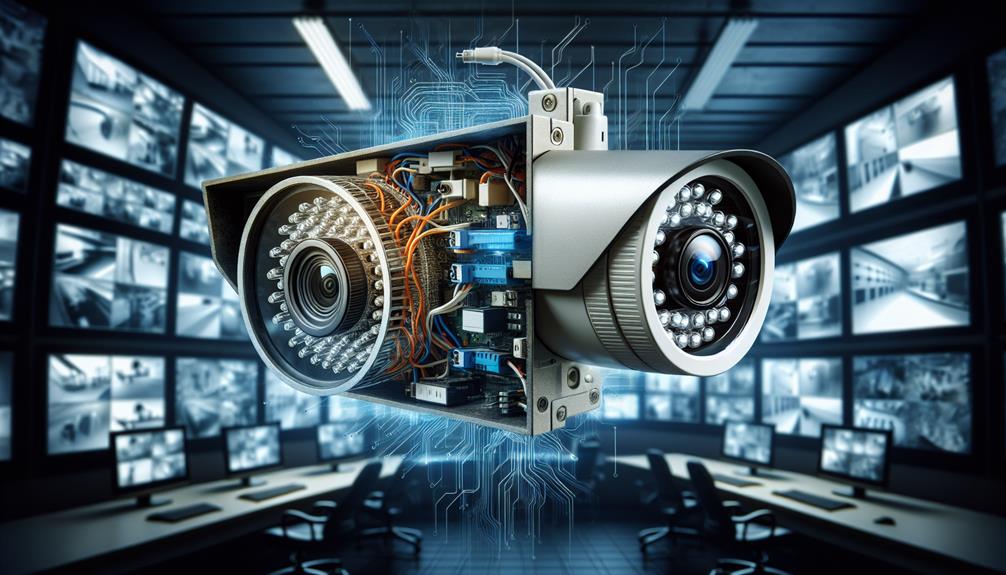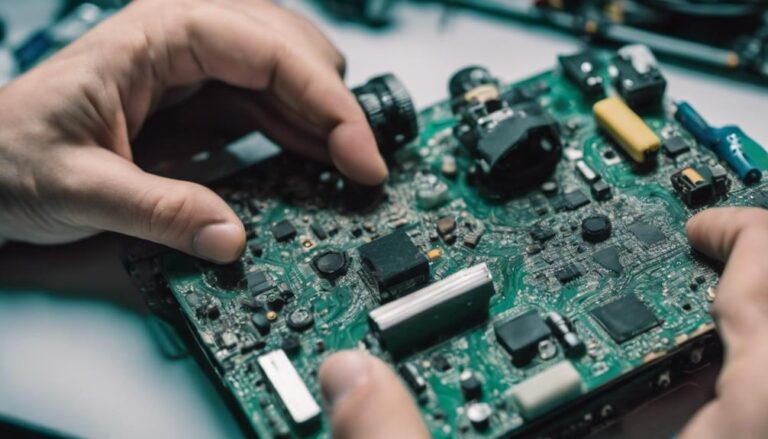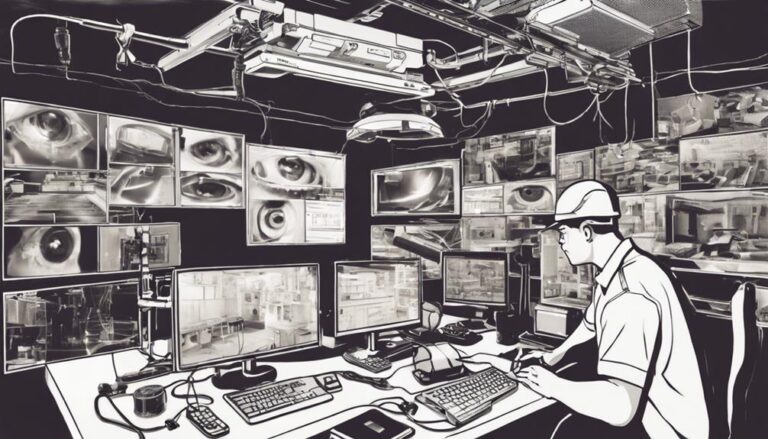When choosing between Analog and IP CCTV, consider your needs. Analog systems are budget-friendly, simple to install, and use coaxial cables. However, IP CCTV offers high-resolution video, remote access, and advanced analytics. It’s also scalable, meaning you can easily add more cameras as needed. While Analog systems have lower initial costs, IP systems provide better video quality and future-proof features like cloud storage and encryption. For reliable, detailed surveillance with remote monitoring, IP CCTV is superior. Continue to discover which system aligns best with your security requirements and long-term goals.
Overview of Analog CCTV
Analog CCTV systems have been a staple in video surveillance for decades, offering a straightforward and cost-effective solution for security needs. You’ll find them easy to install and operate, making them perfect if you value simplicity and efficiency. Each camera in an analog setup sends its video signal to a digital video recorder (DVR) via coaxial cables. This guarantees reliable, uninterrupted footage, so you can keep an eye on things without any digital fuss.
If you’re a freedom-seeker who doesn’t want to be bogged down by complex configurations, analog CCTV’s plug-and-play nature will appeal to you. The cameras don’t rely on network bandwidth, reducing chances of lag or data loss. Plus, analog systems are often more budget-friendly, allowing you to allocate resources elsewhere.
Maintenance is also straightforward. You won’t need extensive technical knowledge to troubleshoot basic issues. Just make sure the cables are intact and the DVR functions correctly. If you’re looking for a hassle-free way to secure your space, analog CCTV can be a reliable choice. It offers the security you need without tethering you to constant tech updates or complicated networking setups.
Overview of IP CCTV
In contrast to analog systems, IP CCTV offers advanced features and flexibility, making it an attractive option for modern surveillance needs. You’ll appreciate the high-resolution video quality that IP cameras provide, capturing clear and detailed images. This importance can be vital for identifying faces, license plates, and other important details.
IP CCTV systems are also scalable. Whether you need to monitor a single room or an entire complex, you can easily add more cameras to your network without overhauling your entire system. This flexibility guarantees that your surveillance setup can grow with your needs.
You’ll have the freedom to access your IP CCTV footage from anywhere with an internet connection. Remote access allows you to monitor your property in real-time from your smartphone, tablet, or computer. This feature is especially useful for those who travel frequently or manage multiple locations.
Moreover, IP cameras often come with advanced analytics capabilities. Motion detection, facial recognition, and object tracking enable smarter surveillance and quicker responses to potential threats. You won’t be tied down by the limitations of older technology. Instead, you’ll enjoy a modern, efficient, and highly adaptable surveillance solution with IP CCTV.
Installation Process
Setting up your IP CCTV system involves a straightforward installation process that enhances the advantages discussed previously. Unlike analog systems, IP CCTV systems offer you the freedom to set up and manage your security setup with ease. You’ll appreciate the flexibility and simplicity that come with modern technology.
First, identify the locations where you want to install the cameras. These spots should maximize coverage and minimize blind spots. Next, mount the cameras securely using brackets and screws. Make sure they’re weatherproofed if they’ll be outdoors.
Connect your cameras to your network using Ethernet cables or opt for a wireless setup. IP cameras require a power source, so either connect them to an outlet or use Power over Ethernet (PoE) for a cleaner setup.
Configure your cameras through the network by accessing their IP addresses. This step allows you to set up motion detection zones, alerts, and other customization options.
Finally, link the cameras to your recording device or cloud storage. This ensures you can access your footage at any time.
- Identify best camera locations
- Mount cameras firmly
- Connect cameras to the network
- Set up camera settings
- Link to recording/storage device
With these steps, you’ll have a robust and flexible surveillance system in place.
Video Quality
You’ll immediately notice a significant difference in video quality when comparing IP CCTV systems to their analog counterparts. IP cameras offer higher resolution, providing you with clearer, more detailed images. This means you can identify faces, license plates, and other vital details with ease. Analog systems, on the other hand, typically max out at lower resolutions, resulting in grainy, less distinct footage.
IP cameras also deliver better performance in low-light conditions. With advanced features like infrared and wide dynamic range (WDR), they capture clearer images even in challenging lighting. Analog cameras struggle in similar scenarios, often producing murky, unusable footage.
Another advantage of IP CCTV is digital zoom. You can zoom in on live or recorded video without losing clarity, giving you the freedom to focus on important areas. Analog systems don’t offer the same flexibility; zooming in usually results in pixelated images.
Moreover, IP systems support intelligent video analytics. Features like motion detection, object tracking, and facial recognition enhance security and provide actionable insights. Analog cameras lack these advanced capabilities, limiting your surveillance options.
In essence, if you value freedom and flexibility in your surveillance system, IP CCTV offers superior video quality and advanced features that analog simply can’t match.
Cost Comparison
When comparing costs, you’ll find that analog CCTV systems generally have a lower initial price tag than IP systems. This affordability makes analog systems an attractive option if you’re looking to stick to a budget. However, it’s crucial to take into account the total cost of ownership, which includes installation, maintenance, and potential upgrades.
Analog systems typically require less expensive cameras and recording equipment. However, the savings may not be as significant when you factor in the following:
- Installation Costs: Analog systems often need more extensive cabling compared to IP systems, which can increase labor costs.
- Maintenance: Analog systems may require more frequent maintenance and replacements due to their older technology.
- Scalability: Adding more cameras to an analog system can be more complicated and costly.
- Upgrades: Upgrading an analog system to improve quality or features can be expensive and sometimes impractical.
- Storage: Analog systems might need more physical space for DVRs and other equipment.
Ultimately, while the initial investment in an analog system might be lower, IP systems can offer long-term savings and flexibility. Weighing these factors will help you make a more informed decision that aligns with your needs and budget.
Remote Access
With remote access, you can monitor your CCTV system from anywhere using a smartphone, tablet, or computer. This feature is particularly beneficial if you value freedom and flexibility in your daily life. IP CCTV systems shine in this area, offering seamless remote access with just a few clicks. You don’t need to be physically present to guarantee your property’s safety. Instead, you can check in from the comfort of your home, while on vacation, or even during a business trip.
Analog systems, on the other hand, often lack this capability or require costly additional equipment to enable remote viewing. With IP CCTV, all you need is an internet connection and the appropriate app or software. You can receive real-time alerts about suspicious activities, watch live feeds, and review recorded footage without being tethered to a specific location. This flexibility not only enhances security but also allows you more freedom to move about your life without constantly worrying about what’s happening when you’re not there.
Incorporating remote access into your CCTV system ultimately provides peace of mind and more control over your security, making it an essential feature for anyone seeking greater autonomy and safety.
Scalability
IP CCTV systems offer remarkable scalability, making it easy to expand and adapt as your security needs grow. Unlike analog systems, which can become cumbersome and costly to scale, IP CCTV systems provide a flexible and efficient solution. Whether you’re looking to add more cameras, integrate with other security technologies, or expand to multiple locations, IP CCTV systems have you covered.
With IP CCTV, you can effortlessly scale your security infrastructure to meet your evolving needs. Here’s why:
- Seamless Integration: You can easily integrate new cameras and devices with existing ones without overhauling your entire system.
- Cost-Effective Expansion: Adding new cameras and components doesn’t require extensive cabling or hardware modifications, reducing costs and complexity.
- Enhanced Flexibility: IP systems support various camera types and technologies, allowing you to customize your setup based on specific security requirements.
- Centralized Management: Manage all your cameras and devices from a single interface, simplifying oversight and control.
- Future-Proof: IP CCTV systems can adapt to new technologies and standards, ensuring your investment remains relevant and effective over time.
Storage Solutions
Selecting the appropriate storage solution for your CCTV system is essential for ensuring reliable and efficient video retention. When it comes to Analog vs. IP CCTV, your choice will influence your storage needs. Analog systems typically use Digital Video Recorders (DVRs), while IP systems often rely on Network Video Recorders (NVRs). Each has its storage options and capabilities.
For Analog CCTV, DVRs usually come with internal hard drives, which might be enough for smaller setups. However, IP CCTV systems have more flexibility. They can use NVRs with internal drives, network-attached storage (NAS), or even cloud storage. This flexibility can be vital if you need scalable storage solutions.
Here’s a quick comparison:
| Storage Solution | Analog CCTV | IP CCTV |
|---|---|---|
| DVR | Yes | No |
| NVR | No | Yes |
| NAS | Limited | Yes |
| Cloud Storage | Rare | Common |
Reliability
Reliability is an essential factor when choosing between Analog and IP CCTV systems. You want a system that you can count on, no matter the circumstances. Analog systems have been around for decades, proving their robustness and dependability in various conditions. They rarely suffer from network issues and are generally more straightforward.
On the other hand, IP systems have their own set of reliability advantages. They offer better image quality and advanced features, but they do depend on your network’s stability. Power outages or network failures can impact their performance. However, modern IP systems often come with redundancies to mitigate these issues.
Consider these points when evaluating reliability:
- Downtime: Analog systems have minimal downtime compared to IP systems that rely on network stability.
- Maintenance: Analog systems require less frequent updates and maintenance, while IP systems need regular software updates.
- Interference: Analog systems are more prone to signal interference, but IP systems can be affected by network congestion.
- Scalability: IP systems are easier to expand and integrate, offering more flexibility.
- Future-proofing: IP systems are more adaptable to future technological advancements.
Choosing the right system depends on your specific needs and how much reliability you’re willing to trade for advanced features.
Security Features
While reliability is critical, examining the security features of Analog and IP CCTV systems reveals distinct strengths and weaknesses. Analog systems, while straightforward, lack advanced encryption, making them more susceptible to interception. If someone taps into your analog feed, they can easily view or even manipulate the footage. This could be a significant downside if you’re looking for a higher level of security.
On the other hand, IP CCTV systems shine with their robust security features. They offer advanced encryption protocols such as SSL/TLS, guaranteeing that your video data remains confidential and tamper-proof. You can also set up user authentication, restricting access to only authorized personnel. This ensures that your footage is far less likely to fall into the wrong hands.
However, it’s important to remember that IP systems, while more secure, require diligent maintenance. Regular updates and strong passwords are vital to prevent cyber-attacks. Don’t let your guard down just because you’ve got a more advanced system.
Frequently Asked Questions
How Does the Power Consumption Compare Between Analog and IP CCTV Systems?
When comparing power consumption, analog CCTV systems sip power like a gentle breeze, whereas IP systems often guzzle electricity like a roaring river. If you’re craving energy efficiency, analog systems might be your go-to choice.
What Are the Maintenance Requirements for Both Analog and IP CCTV Systems?
You’ll find that maintenance for both systems includes regular software updates, camera cleaning, and occasional hardware checks. IP systems might need more frequent updates, but both require a proactive approach to guarantee reliability and performance.
Can Analog and IP Cameras Be Integrated Into the Same Surveillance Network?
Imagine blending old and new, like merging past and future. Yes, you can integrate analog and IP cameras in the same surveillance network. With the right technology, you’ll create a seamless, unified security system.
How Do Weather Conditions Affect the Performance of Analog Vs. IP CCTV Cameras?
Weather conditions can impact camera performance. Rain, fog, and extreme temperatures might degrade image quality or cause malfunctions. Weatherproof housings and proper upkeep guarantee dependable performance in both analog and IP CCTV cameras.
What Are the Typical Lifespans of Analog and IP CCTV Systems?
Picture your security setup as a trusty watchdog. Analog systems usually last around 5-7 years, while IP systems can serve you for 10 years or more. Choose wisely and enjoy the peace of mind and freedom.



